PERENNIALS > CYCLAMEN
Chris is a gardening writer and nature enthusiast. He graduated from Oxford Brookes University in 2022 with an MA in Psychology. Chris works with the Leeds Green Action Society, helping their food cooperative by growing various fruit and vegetables on their two allotments in Hyde Park, Leeds.
Reviewed By COLIN SKELLY

Colin is a Horticulturist and Horticultural Consultant with experience in a range of practical and managerial roles across heritage, commercial and public horticulture. He holds the Royal Horticultural Society’s Master of Horticulture award and has a particular interest in horticultural ecology and naturalistic planting for habitat and climate resilience.
Contributions From TREVOR WILTSHIRE

Trevor Wiltshire is the Registrar of The Cyclamen Society. He has previously worked at the RHS Wisley site, as the Alpine Garden Society Cornwall Group Secretary and as former Executive Committee Member of Cornwall Garden Society.

Noel Kingsbury is an award-winning Garden Designer and Author of 25 gardening books, including The New Perennial Garden and Garden Flora. He is also the Co-Founder of Garden Masterclass, an online guide that produces video and film tutorials to help gardeners free of charge. Noel obtained his PhD in 2009 from the Sheffield University Department of Landscape, specialising in the ecology and behaviour of ornamental perennials.
IN THIS GUIDE
Cyclamen is a cute and attractive family of flowers that bring reds, pinks, purples, and whites to your outdoor spaces.
They’re hardy perennials, making them popular choices for British gardeners, and, depending on the varieties you choose, they can bring colour to your garden year-round.
This plant is so popular in some places that its populations have been depleted by illegal collection, making them endangered.1Cyclamen – Cyclamen hederaefolium. (n.d.). Brickfield Spark. Retrieved March 14, 2023, from https://www.brickfieldspark.org/data/cyclamen.htm

By growing cyclamen in your garden you could be contributing toward the preservation of at-risk species, which is an exciting prospect.2Yesson, C., & Culham, A. (2006). A phyloclimatic study of Cyclamen. BMC Evolutionary Biology, 6(1), 72. https://doi.org/10.1186/1471-2148-6-72
We have collaborated with Trevor Wiltshire from The Cyclamen Society in writing this guide.
Trevor has a particular fondness for cyclamens, citing his interest in the species: “They are permanent perennials that need very little care and provide interest and colour for 11 months of the year when a wide range of species are grown”.
Overview
| Botanical Name | Cyclamen |
| Plant Type | Perennial Flower |
| Native Area | Europe / Mediterranean |
| Hardiness Rating | H1C – H4 |
| Foliage | Leaf shape varies |
| Flowers | Various, usually pink, white or purple |
| When To Sow | January, February, March, October, November, December |
| Flowering Months | January, February, March, April, May, June, August, September |
Sunlight
Preferred
Mostly Partial Shade
Exposure
Sheltered
Size
Height
15cm
Spread
15cm
Soil
Preferred
Most Soil Types
Moisture
Moist but well drained
pH
Any
Cyclamen from UK garden centres – whether you buy the plant or the seed – is propagated responsibly, so you don’t need to worry about contributing to the threat wild cyclamen plants face.
Cyclamen is a genus of plant that contains 24 species; all of which are perennial.3Cyclamen L. (n.d.). Kew Royal Botanic Gardens. Retrieved May 15, 2023, from https://powo.science.kew.org/taxon/urn:lsid:ipni.org:names:32774-1#children
The family is native to Europe, with some species as far-reaching as Iran and eastern Africa.

While all species share the same broad colour palette, there are aesthetic differences between them.
Depending on the look you’re going for, different species will appeal more than others.
When choosing cyclamen for your garden, be sure to know what it will look like throughout its lifespan.
These plants are perennial, meaning they’ll come back year after year.
Rushing the decision, or buying seeds without researching the adult plant, could be a mistake that sticks with you for a long time.
Cyclamen Varieties
“I adore hardy cyclamen because they are amazing little plants for autumn into winter and early spring, often growing in quite difficult places where not much else grows, like shade under trees,” shares Garden Designer Noel Kingsbury.
“They are small scale but are wonderfully indestructible and unusual little flowers.”
The cyclamen genus is smaller than some other garden plants, with just 24 species.
When asked about his favourites, Trevor notes: “Cyclamen coum for mid-winter colour and foliage interest, C. graecum in walls (Cornish hedges) and raised beds to give nice foliage and then good flowers in late summer.
“C.hederifolium [is great as] as a ‘bomb proof’ all round garden plant in shade and woodland.”
Here are a few favourites to get you started:
C. ‘Laser Rose’
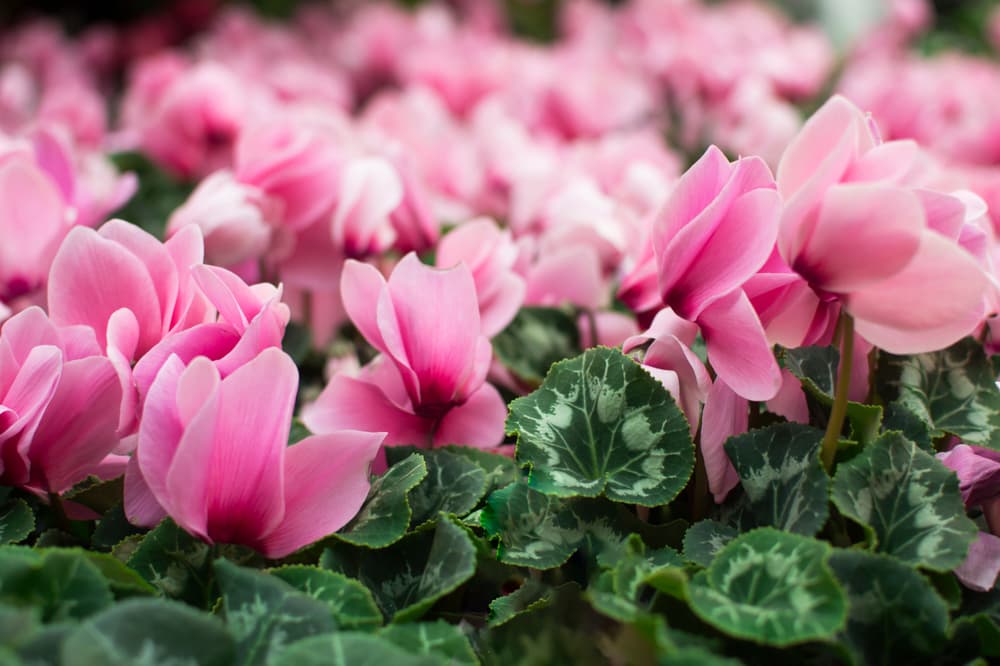
Despite the futuristic name, this soft-pink cyclamen brings a calming energy to outdoor spaces.
It thrives in partial shade, with a south, east, or west-facing aspect.
It’s not fussy when it comes to soil: you can grow it in sand, clay, chalk, or loam; at most accepted pH levels.
After planting it’ll take 2-5 years to reach its maximum height of about half a metre.
This variety will burst forth with pink flowers in winter.
C. ‘Sierra Scarlet’

These flowers have a lovely blend of crimson and vintage pink, providing an engaging splash of colour in the winter months.
The variety grows quicker than the ‘Laser Rose’, taking one year to reach its full height and spread of about half a metre each.
C. rhodium (Peloponnesian Cyclamen)

This variety sports lantern-shaped flowers with light pink tops and rich, deep pink bottoms.
They’re smaller than previous cyclamens, reaching a height and spread of about 10cm over 1-2 years.
You’ll enjoy a pink explosion in springtime if you go for this variety.
Planting Cyclamen
This guide details how you can grow cyclamen from bulbs, or via transplanting – growing from seed is a whole different ball game, and we’ve not covered that here.
You can buy young cyclamen plants from traditional garden centres, online merchants and everywhere in between.
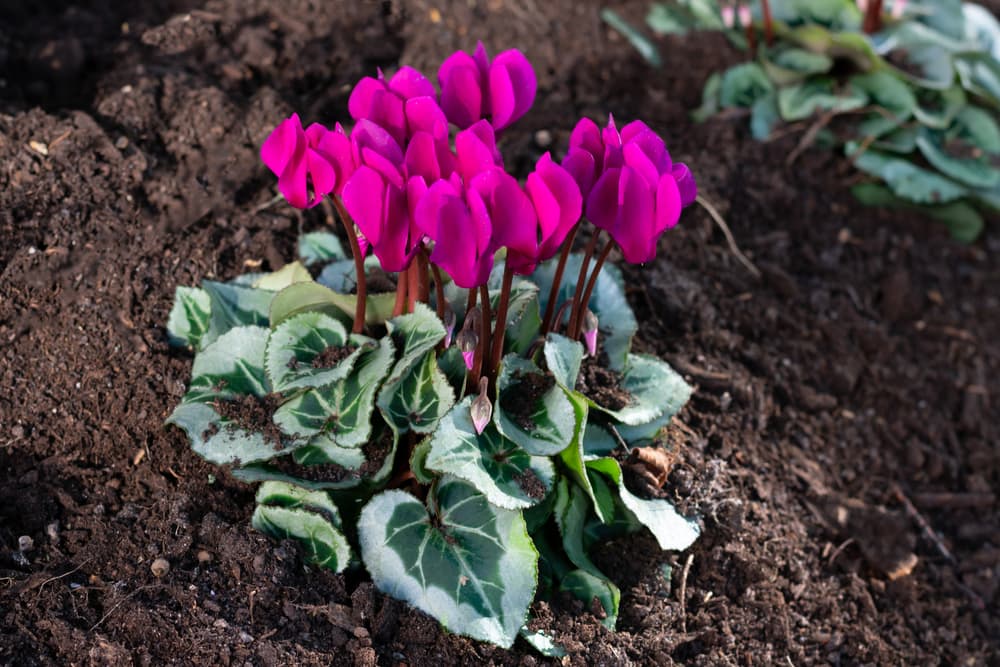
You can also buy young plants that need to be transplanted, a process which is quite easy.
Soil Requirements
All the varieties featured above are happy in loamy, sandy, clayey, or chalky soil.
Cyclamens prefer well-drained soil but are not fussy when it comes to pH levels.
Where To Plant
Although different varieties flower at different times, try to avoid mixing varieties in the same area.
Intuitively, this seems like a way to alternate flowering seasons and guarantee colour year-round, but what actually happens is that one variety will dominate – and eventually kill off – the other.
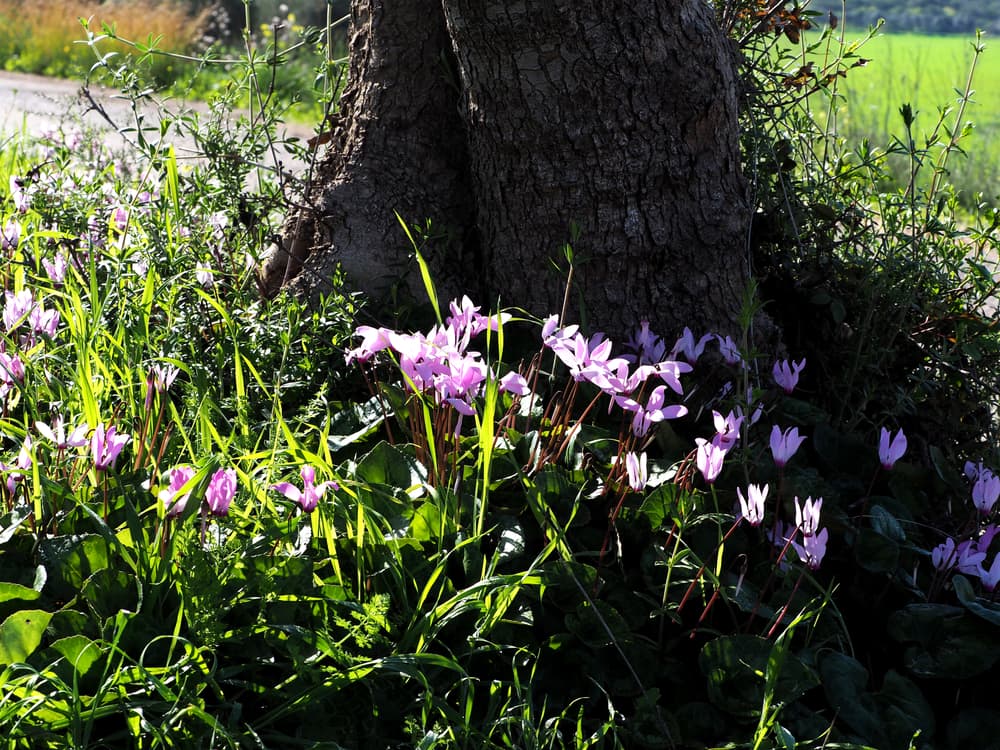
With this in mind, you’ll want to leave about a metre between varieties.
Because cyclamen is quite a low-profile plant, many gardeners use it as ground cover for roses or other taller plants.
Most varieties will thrive in partial shade, with west, south, or east-facing aspects, and a bit of shelter.
The space underneath a tree can often be ideal, as Horticultural Consultant Colin Skelly explains:
“I tend to plant Cyclamen underneath deciduous trees or shrubs because they provide a sheltered environment in summer and winter, provide leaf mulch and a bright winter environment where they can flower whilst most other plants have died back.”
Again, double-check the preferences of the varieties you’re considering incorporating into your garden.
When To Plant
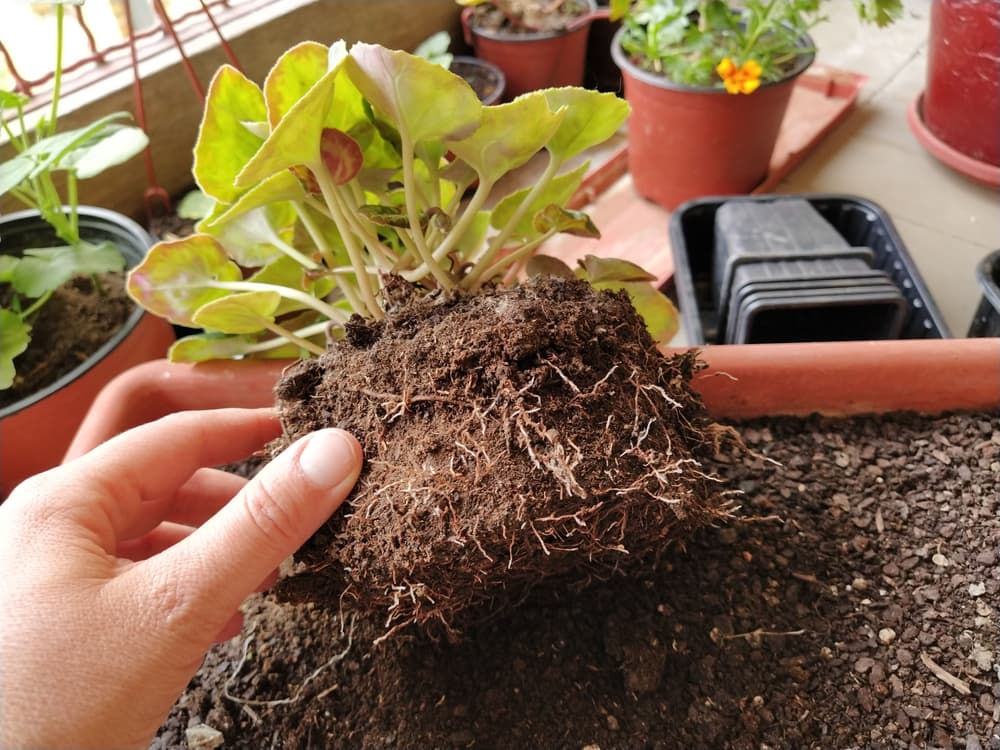
To give your cyclamens the best shot, you’ll want to plant them in autumn, winter (if the ground allows), or early spring.
These plants shouldn’t present too much of a challenge, as long as you choose a spot that’s not too sunny.
Planting Out
As we’re discussing either bulbs or young plants in this article, your first step when planting cyclamen is to dig a hole.
Then, whack in a bit of gravel and sand at the bottom to provide drainage.
Cyclamen bulbs are prone to rotting if they’re overwatered, so this is important.
Next, plop the bulb at the bottom of the hole, or push down the young plant until it’s securely in the ground, then gather soil around the top and water thoroughly.

It’s recommended that you wait until your bulb (or tuber) is showing roots.
This helps you to distinguish the top from the bottom and improves the chance of successful growth.
Plant Hardiness
Amongst the varieties above, the hardiness rating varies between H1C and H4.
You can grow plants with the former rating outdoors in summer, with a preferred minimum temperature range of 5-10°C.
Plants rated H4 are suited to the UK climate year-round, excepting very extreme conditions.

Depending on your location and needs, your ideal hardiness rating will vary.
We always recommend researching the properties of the specific varieties you’re interested in, and choosing the most suitable.
Cyclamen Plant Care
This plant thrives with even watering and cool temperatures.
It will die back out of season: the leaves will die away, and it may look like hope is lost for another year of colour, but be patient.
The bulbs will flower again, and the plant will return to its former glory.

Mulching in winter with leaf-mould will nourish the soil around your cyclamens and help them to grow back big and strong next year.
Pruning
Remove all dead plant matter during the down season for aesthetic reasons.
The cyclamen family is bursting with attractive and relatively easy-to-grow plants that will bring colour and excitement to your garden.
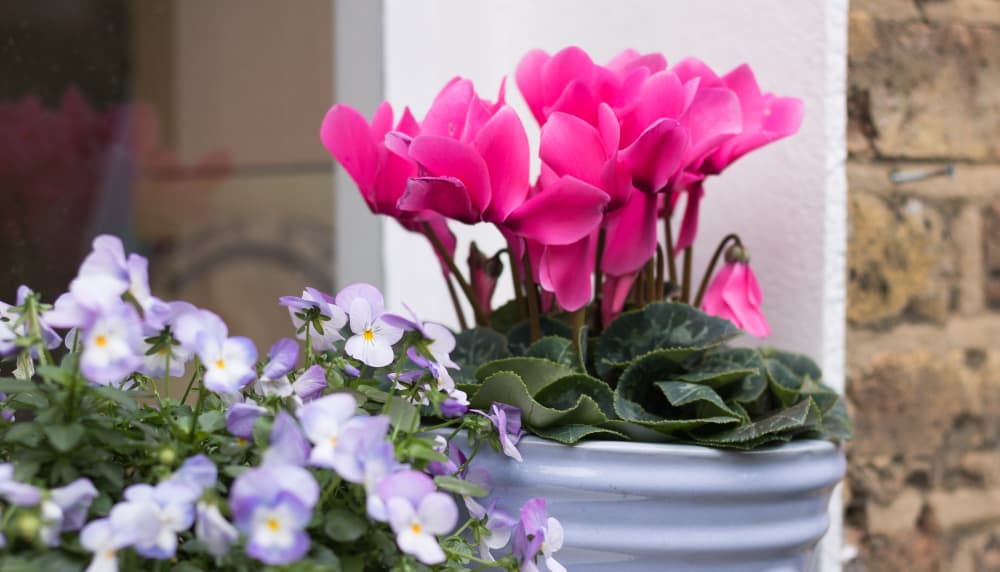
A careful selection of varieties will ensure visual interest year-round, and with a little bit of care, you should be on track for healthy and rewarding plants.
We hope this cyclamen growing guide has been a useful starting point. Enjoy your gardening!
References
- 1Cyclamen – Cyclamen hederaefolium. (n.d.). Brickfield Spark. Retrieved March 14, 2023, from https://www.brickfieldspark.org/data/cyclamen.htm
- 2Yesson, C., & Culham, A. (2006). A phyloclimatic study of Cyclamen. BMC Evolutionary Biology, 6(1), 72. https://doi.org/10.1186/1471-2148-6-72
- 3Cyclamen L. (n.d.). Kew Royal Botanic Gardens. Retrieved May 15, 2023, from https://powo.science.kew.org/taxon/urn:lsid:ipni.org:names:32774-1#children

